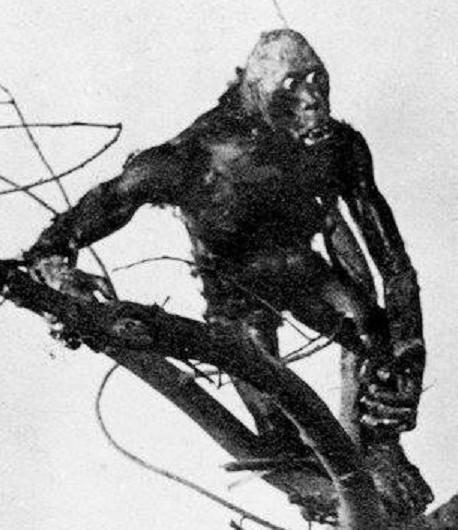Wild Willie
| |||||||||||||||||||||||||||||||||||||||||||||||
Wild Willie is an ape creature who appeared in the 1915 silent comedy short The Dinosaur and the Missing Link: A Prehistoric Tragedy. This film was the debut of legendary stop-motion animator Willis O'Brien, who considered Wild Willie to be King Kong's figurative ancestor.[1][2]
Name
Willis O'Brien, the creator of The Dinosaur and the Missing Link: A Prehistoric Tragedy, likely named Wild Willie after himself. Willie is also the "Missing Link" in the film's title; upon the film's re-release in 1917, this part of the title was changed to "Baboon." In a shot list for the film submitted to the U.S. Copyright Office on March 28, 1917, Wild Willie is simply called "monkey" in descriptions of the action.[3]
Development
After shooting test footage of a stop-motion Brontosaurus in 1914, marble shop sculptor Willis O'Brien convinced San Francisco-based exhibitor and producer Herman Wobber to give him $5,000 to film a short film, titled The Dinosaur and the Missing Link: A Prehistoric Tragedy. His Brontosaurus had a wooden armature and a clay covering, the latter requiring smoothing after every frame due to its great malleability;[1] for the short film, O'Brien's characters sported metal ball-and-socket skeletons and sections of rubber for skin, their joints sealed with a latex solution.[4] Wild Willie, the titular Missing Link, was also covered in rabbit fur. O'Brien shot the film in the basement of San Francisco's Imperial Theatre.[1]
Design
Wild Willie is a humanoid simian with lanky arms and dark fur.
Personality
Known as the "terror of the countryside," Wild Willie stole food from a group of cave people while they were inside their cave. He was more confrontational against a sauropod, who he attacked after mistaking its tail for a snake, although the dinosaur's strength became his undoing.
History
The Dinosaur and the Missing Link
Wild Willie watched a group of cave people from a tree and descended to raid their food stores when they all went inside. Mr. Rockface tasked the Duke, Stonejaw Steve, and Theophilus Ivoryhead—who were all competing for the affections of his daughter Araminta—with killing something new for dinner. He assigned Theophilus, the smallest of the three, the lowly job of catching fish. Meanwhile, Wild Willie journeyed to a stream to grab a few snakes to eat. He mistook the tail of a sauropod for a large snake, angering the dinosaur when he bit the tip of the tail and bashed it with a rock. After noticing the rest of the sauropod, he threw the rock at its side and climbed onto its back to fight it. He landed a few punches, but the sauropod soon scored a fatal blow. Theophilus, a witness to the battle, confirmed his death, then boasted that he had effortlessly killed the Missing Link himself, winning Araminta’s heart.
Abilities
Physical abilities
Wild Willie was skilled at climbing both trees and sauropods, also jumping over three swings of the latter’s tail. He was a tool user, employing a boulder against the sauropod, and followed up the throw with bites and punches.
Weaknesses
The sauropod who battled Wild Willie apparently killed him simply by throwing him to the ground, where he cracked his head on a rock.
Gallery
- Main article: Wild Willie/Gallery.
Videos
|
References
This is a list of references for Wild Willie. These citations are used to identify the reliable sources on which this article is based. These references appear inside articles in the form of superscript numbers, which look like this: [1]
|
Bibliography
- Harryhausen, Ray; Dalton, Tony (2008). A Century of Stop-Motion Animation: From Méliès to Aardman. Watson-Guptil. ISBN 978-0823099801.
- Goldner, Orville; Turner, George E (1976). The Making of King Kong: The Story Behind a Film Classic. Ballantine. ISBN 978-0345251343.
Comments
Showing 37 comments. When commenting, please remain respectful of other users, stay on topic, and avoid role-playing and excessive punctuation. Comments which violate these guidelines may be removed by administrators.

